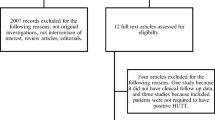Abstract
Introduction: In this study, patients with rate hysteresis pacemakers implanted for vasovagal syncope were re-studied using serial tilt testing to determine whether, once triggered, pacing was more effective if the intervention rate was higher than the standard rate.
Methods and Results: Twenty patients (mean age 55.4 years, range 23–81, 14 male) were studied, with randomisation to either initial standard rate (80–90[emsp4 ]beats/min) intervention, or to initial high rate (120[emsp4 ]beats/min) intervention. Although 18 of the 20 reported complete abolition of syncope since pacing, only 8 patients could be objectively assessed. The respective mean time to tilt down after symptom onset with standard and high rate intervention was 193±234[emsp4 ]s and 185±143[emsp4 ]s, (P
>0.05).
Conclusion: Repeat tilt testing was only of limited value in assessing the benefit of pacing. There was no advantage with high rate intervention in delaying the loss of consciousness (or intolerable symptoms) after the initial onset of symptoms.
Similar content being viewed by others
References
Gregortos G, Cheitlin MD, Conill A, Epstein AE, Fellows C, Ferguson TB, et al. ACC/AHA guidelines for implantation of cardiac pacemakers and antiarrhythmia devices: Executive Summary. A report of the American College of Cardiology/American Heart Association Task Force on Practice Guidelines (Committee on Pacemaker Implantation). Circulation 1998;97:1325-1335.
Clarke M, Sutton R, Ward D, Camm AJ, Rickards AF, Ingram A, et al. British Pacing and Electrophysiology Group Working Party. Recommendations for pacemaker prescription for symptomatic bradycardia. Br Heart J 1991;66:185-191.
Benditt DG, Sutton R, Gammage MD, Markowitz T, Gorski J, Nygaard GA, Fetter J. 'Rate-drop response' cardiac pacing for vasovagal syncope. Rate-drop response Investigators Group. J Interv Card Electrophysiol 1999;3(1):27-33.
Ammirati F, Colivicchi F, Toscano S, Pandozi C, Laudadio MT, De Seta F, Santini M. DDD pacing with rate drop function response versus DDI with rate hysteresis for cardioinhibitory vasovagal syncope. PACE 1998;21(II):2178-2181.
Penàz J. Photoelectric measurement of blood pressure, volume and flow in the finger. In: Digest of 10th International Conference on Medical and Biological Engineerng, Dresden 1973;104:2-7.
Petersen MEV, Williams TR, Sutton R. A comparison of non-invasive continuous finger blood pressure measurement (Finapress) with intra-arterial pressure during prolonged head up tilt. Eur Heart J 1995;16:1647-1654.
Fitzpatrick BP, Theodorakis G, Vardas P, Sutton R. Methodology of head-up tilt test in patients with syncope. J Am Coll Cardiol 1991;17:125-130.
Kurbaan AS, Franzén A-C, Bowker TJ, Williams TR, Kaddoura S, Petersen MEV, Sutton R. Usefulness of tilt induced patterns of heart rate and blood pressure using a two stage protocol with glyceryl trinitrate provocation in patients with syncope of unknown origin. Am J Cardiol 1999;84:665-670.
Petersen MEV, Chamberlain-Webber R, Fitzpatrick AP, Ingram A, Williams T, Sutton R. Permanent pacing for cardio-inhibitory malignant vasovagal syndrome. Br Heart J 1994;71:274-281.
Connolly SJ, Sheldon R, Roberts RS, Gent M on behalf of the Vasovagal Pacemaker Study investigators. The North American Vasovagal Pacemaker Study (VPS). A randomised trial of permanent cardiac pacing for the prevention of vasovagal syncope. J Am Coll Cardiol 1999;33:16-20.
Brignole M, Sutton R, Raviele A, Alboni P, Moya A, Menozzi C, Giani P. Dual chamber pacing is efficacious in treatment of neurally mediated tilt positive cardioinhibitory syncope pacemaker versus no therapy: a multicentre randomised study. Circulation 1999;100(Suppl I): I-642.
Fitzpatrick A, Theodorakis G, Ahmed R, Williams T, Sutton R. Dual chamber pacing aborts vasovagal syncope induced by head-up 60 degree tilt. PACE 1991;14:13-19.
Samoil D, Grubb BP, Brewster P, Moore J, Temesy-Armos P. Comparison of single-and dual chamber pacing techniques in prevention of upright tilt-induced vasovagal syncope. Eur J Cardiac Pacing Electrophysiol 1993;3:36-41.
Gammage MD, Hess M, Markowitz T. Initial experience with rate drop response algorithm in malignant vasovagal syncope. Eur J Cardiac Pacing Electrophysiol 1995;53:45-48.
Chen XC, Chen MY, Remole S, Kobayashi Y, Dunnigan A, Milstein S, Benditt DG. Reproducibility of head-up tilt table testing for eliciting susceptibility to neurally mediated syncope in patients without structural heart disease. Am J Cardiol 1992;69:755-760.
Fitzpatrick AP, Theodorakis G, Vardas P, Sutton R. Methodology of head-up tilt test in patients with syncope. J Am Coll Cardiol 1991;17:125-130.
Reybrouck T, Heidbüchel H, Van de Werf F, Ector H. Tilt training: A treatment for malignant and recurrent neurocardiogenic syncope. PACE 2000;23(4):493-498.
Author information
Authors and Affiliations
Rights and permissions
About this article
Cite this article
Kurbaan, A.S., Franzén, AC., Stack, Z. et al. Determining the Optimal Pacing Intervention Rate for Vasovagal Syncope. J Interv Card Electrophysiol 4, 585–589 (2000). https://doi.org/10.1023/A:1026509430078
Issue Date:
DOI: https://doi.org/10.1023/A:1026509430078




